If you’ve been transitioning to natural hair for a while now, or even if you just started, you know the life of a naturalista can be one filled with joy at the sight of their beautiful new curls. Nevertheless, you also know that it takes some work and planning to have those curls continuing to grow healthy and strong. There are daily, weekly and monthly hair care practices all transitioners should engage with to make sure their journey runs along as smoothly as possible. Thinking solely of your success, I put together all those tasks. You can check if you’ve been a good girl.
DAILY
HAIR CARE PRACTICES FOR TRANSITIONERS
1| Check Hair For Moisture. We all know natural hair needs moisture to survive. Even if you think you moisturised your hair enough to last you until your next wash day certain conditions, such as the weather, can alter your hair’ moisture level. Be mindful of this and always have your favourite moisturiser at hand or a simple spray bottle with some DIY leave in solution. It really doesn’t take much to make your hair happy. Keep a journal of how and when you moisturise your hair, it will help you understand what products keep hair moisturise for longer.
2| Sleep On A Satin Pillowcase Or Bonnet. Avoid having the moisture you worked so hard to layer into your hair from being drained while you sleep on a cotton pillowcase. Satin is more gentle on your hair, it won’t dry, snag or break it. Alternatively, you can wear a satin scarf tied around your hair to protect it.
3| Arrange Hair To Sleep. Having your hair free and loose at night, even if obeying point number two, invites tangles and makes your hair lose curl definition or texture from braids or twists. The best you can do is a pineapple (a high ponytail arranged at the top of your head) or you can make braids or twists. However, doing braids or twists every night can turn into excessive manipulation and cause breakage for some hair types. For other people, it is necessary to maintain some sort of hairstyle. Pay attention to your hair.
4| Hands Off! Your hair is an extension of yourself, not a pet you need to stroke all the time as if you’re saying “Good boy!!! (was I too strong in my analogy?! My apologies, I just need to keep the message clear). Touching your hair all the time removes moisture, creates frizz and can increase breakage if your hair is already fragile.
5| Drink Water. Water makes up most of our bodies, so it’s no wonder this is included here. Think of your hair as a beautiful flower that needs constant water to grow and thrive. If not enough water is supplied your hair will fall short of its full potential even if you care for its remaining needs. Drink plenty of water or tea.
6| Eat Properly! Just as drinking plenty of water is important, so is having a balanced and diverse diet. Don’t endorse fad diets or embark on a diet full of fats and empty nutrients. It’s one thing to reward yourself once in a while, it’s an entirely different thing for that to become your lifestyle. Watch what you eat and it will reflect on your hair’s health.
WEEKLY
HAIR CARE PRACTICES FOR TRANSITIONERS
1| Pre-Poo. This is the foreplay to your washing day. This is when you show your hair how much you love it and what you are willing to do to make it happy. Pre-pooing is of paramount importance to natural hair and if you don’t know why then you should head over here to discover. While you’re at it, here are my favourite oils to begin your journey, here are some recipes for your pre-poo and how to make it more effective.
2| Oil Massage. This not only avoids dry scalp but it also stimulates hair growth. This is maybe not on everyone’s list, but think about doing it at least once a week and do it while you’re pre-pooing. Nothing like killing two birds with one stone, especially when our wash day can be so intense. When you see how much your hair has grown you’re gonna scream “Holy Cr*p!What just happened?”, plus you’ll be giving yourself some much-needed relaxation time.
3| Wash Hair Weekly (or bi-weekly at most) to remove all sweat, dirt, hair product, pollution, make-up and maybe perfume (some people have to have it eve-ry-where!). You need to have a clean hair and scalp for it to grow healthy. Your dirty scalp can be a fun-fair for bacteria. A study performed on men found that some men’s beards harboured bacteria similar to those found in faecal matter (yikes!). It’s true we have millions of bacteria on our skin that actually benefits us, but if off balanced it can develop into a serious condition.
4| Detangle, don’t delay it! You might be thinking “Duh, Monica, of course, you have to detangle your hair! That goes without saying”. Yeah, yeah, I know you all ladies know this, but I also know sometimes the thought of another wash day and the detangling session that comes along with it is enough to delay it for a couple more days. But ladies, doing this only invites for a more difficult wash day with the loss of patience when detangling, more broken hairs and a stressful day. Detangle your hair weekly!
5| Deep Condition. Another practice for which there should be a law to enforce it. Let your hair be replenished by using a deep conditioner weekly. Imagine if you were pushed, tugged or frequently manipulated, imagine if you had to endure low or high temperatures or strong gusts of wind, imagine yourself weak and withering as this continues. Girl, you gotta give your hair some love! Deep conditioning is to natural hair as spinach is to Popeye, an elixir of strength and endurance.
6| Use A Microfiber Or Jersey Towel when you do your weekly washing routine. Avoid breakage and foster a kinder hair manipulation. Check out some microfiber towels here or you can also check Breezy Tee’s jersey towels, and while you’re at it also check their satin lined beanies. Read How To Star Caring For Transitioning Hair.
7| Protective or Low Manipulation Hairstyles. Think about styling your hair in a way that doesn’t need daily manipulation (either by setting it every night or by keeping it out of your face). Sure we all love a Wash & Go, but we also know that if left for too long (+4 days) your wash day will be a festival of tangles and knots. I wouldn’t wanna go to that Rock concert! Read more about Protective Hairstyles.
8| Keep Hair Journal Up To Date. Every week you should keep a record of what you do to your hair like hair products used and how they were used, hairstyles, need for mid-week moisture, type of deep conditioner, if you trimmed your hair, any DIY recipes you tried… you get my drift. A hair journal like this one will help you understand your hair needs, likes and moods. It will help you improve your hair regimen and also reach your goals successfully.
MONTHLY
HAIR CARE PRACTICES FOR TRANSITIONERS
1| Clarify Hair. You need to remove from your hair all residues of hair product, water minerals, vegetable oils, silicone and butters that remain on your hair even after cleansing it. These accumulate over a period of time and they prevent your hair from being properly moisturised. Over time, you experience dryness, brittle hair and breakage. Depending on how frequently you use these ingredients and wich ones you’re using, and depending on how heavy your tap water is these film forming ingredients will need to be removed. You may need to increase your clarifying session from once a month to maybe more.
2| Trim Hair. Calm down! I’m not saying you have to trim your hair every month, but you do have to do it every couple of months. If you’re transitioning you know your relaxed hair is weaker and is damaged by all the chemical procedures. This means that split ends and breakage are only a wash day away, therefore, to avoid this scenario from getting worse, you should, at least, trim your ends every 2 to 3 months. As I like to say, you need to trim to achieve healthy hair.
3| Protein Deep Conditioner. Every month you should be doing this to strengthen your hair, to infuse deep moisture and to maintain and improve elasticity. Assess your hair’s health and practices (severely damaged or not, heat styling, dyeing, etc) and decide how often you should do it. You should aim for a minimum of once a month or every 6 weeks if you don’t engage in damaging practices, but you’ll need more if you do. Read Know Your Deep Conditioners Jump-Start Your Results.
4| Keep Tools & Accessories Clean. Just as you clean your hair you also need to clean your tools. Your brushes, combs, diffusers, comb attachments, hairbands, scrunchies and the like need to be cleaned from all the products that transfer from your hair to them and. Moreover, some might even get a mouldy smell and you need to ditch them, you don’t want anything growing on your head.
5| Check Your Products. Check you product stash and confirm if you need to repurchase any favourite or give away any flops. Don’t forget to record in your hair journal your product score and why you liked/disliked them. This will help you know/remember the best way to use a specific product you like or will help you to simply remember you bought that product in the past and didn’t like it. Definitely, something that will help a lot of product junkies out there. Need help shopping? Check this post.
6| Review Hair Goals. If you’ve been keeping a hair journal every week and recording everything you do to your hair this task will be easier. Sometimes you need to review your hair goals, you need to tweak them. Maybe, you don’t need that much protein in your regimen, maybe you need to do more protective hairstyles cause you’re noticing a little hair breakage, maybe you need to incorporate more techniques that foster hair growth, maybe your scalp is itchy and you need to change your shampoo… you see where I’m going?! A goal without a plan is a wish. Plan!
There you have it, your daily, weekly and monthly hair care practices. After looking and reading through all of them you may feel that transitioning is way too much work, but for you to have the hair you envision and long for, this work needs to happen backstage. I’m sure you heard it before, but nothing worth having comes easy. And yet, some of you might even be surprised by how much you already do as seeing things written down makes them more measurable. If you want to keep yourself on track feel free to click and download the checklist and maybe laminate it to use and reuse.
Let me know what other things you do each week in your transitioning journey and please take a moment to comment, like, share with other people who are going through this journey.

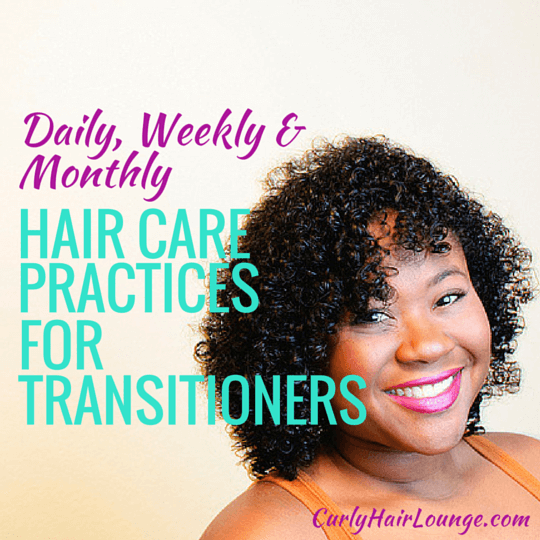

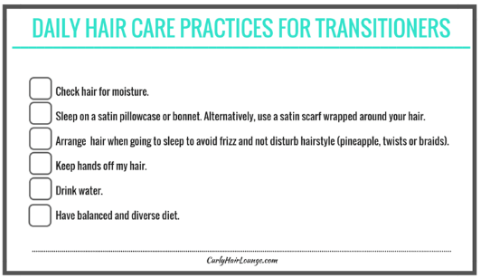
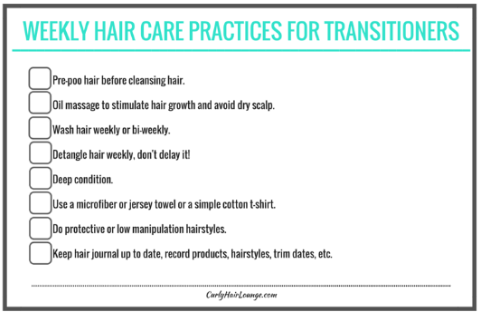
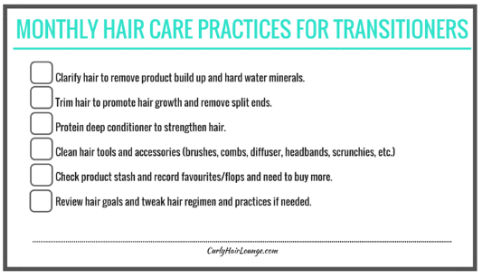

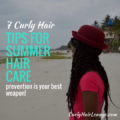
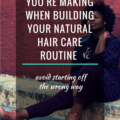

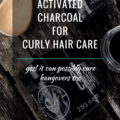
2 thoughts on “Daily Hair Care Practices For Transitioners”
I have been slacking on my pre-poo sessions and must start to practice them again.
Hi, Lelogang! Yes, pre-poos are an amazing addition to your hair regimen. I started doing them at the onset of my transitioning journey and continued to do so now that I am completely natural. I know that sometimes we can get a bit lazy or forget to do it. I normally do it the night before my wash day, so my it isn’t such a long day and to get the most of my pre-poo. One thing you can do is set an alarm on your mobile (maybe two, just in case) with an encouraging message. Whenever I feel lazy and think “Oh, it’s just this once”, I always picture my hair as dry has hay, and it does the trick for me.
Well, now that you’re planning to get back at doing your pre-poos again have you read my post on making your pre-poos more effective or >this one< which has 3 recipes? I hope they're helpful. If you need help with building a hair regimen read >this one< as well. I hope to see you here again! Happy Curly Adventures :)